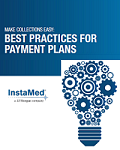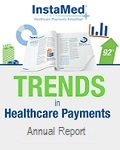 By Deirdre Ruttle, Chief Marketing Officer, InstaMed
By Deirdre Ruttle, Chief Marketing Officer, InstaMed
Twitter: @InstaMed
Twitter: @deirdre_ruttle
Rising Patient Payment Responsibility
Today’s patients owe more for their healthcare than ever before. Steady increases in health plan premiums and high deductible plans lead to ever-growing patient financial responsibility. The Kaiser Family Foundation’s 2019 annual employer benefits survey notes that the average family coverage premium rose by 54% over the prior ten years. Employee wages, however, have not grown at nearly the same speed. Additionally, deductibles remain a crucial driver of patient out-of-pocket costs, adding to the payment responsibility strain. The number of patients with employer-sponsored coverage with deductibles rose to 82%.
As patient payment responsibility grows, so does the worry about whether they can pay these rising healthcare costs. In fact, 73% of patients express concern about their ability to pay their medical bills. The pressure of uncertainty of COVID-19 also heightens financial hardships as unemployment concerns press on.
In addition, recent data shows that demographics like gender and age can shift the impacts of patient financial strain. For example, millennials are two times more likely to avoid healthcare due to cost than baby boomers.
Personalizing Payment Options Helps Both Patients and Providers
The growth in patient out-of-pocket responsibility impacts payment preferences. Patients want convenient, easily accessible and easy to understand options to help them navigate their medical expenses. 83% of patients prefer digital payment options like those they use for their non-healthcare bills to pay for their medical expenses. The emergence of COVID-19 and the need for social distancing drive even more demand for digital options. Contactless technologies, such as mobile wallets and EMV chips, enable safe on-site payments without ever having to touch a keypad or hand a credit card over to office staff.
Digital payments can help eliminate the friction between patients and providers within the payment process. With payment options that fit their circumstances, patients can better manage medical expenses before balances reach collections. Empowering patients with personalized experiences not only helps providers get paid quicker, but also helps streamline back-office processes.
Keeping in mind the many factors to consider, between demographics and financial components, there is no one-size-fits-all payment solution. To fit patients’ specific needs, providers must create flexible payment experiences.
As the financial burden of COVID-19 stretches across the healthcare industry, maintaining steady revenue is more critical than ever. Taking steps to personalize the payment experience can increase collections while the pandemic continues and beyond.
Save Cards on File to Streamline and Automate Payments
Patients want simple choices to control their healthcare payments. One way to achieve this is to empower them to schedule payments based on their preferences and budgets through automated payments. You’ll need to implement a process to securely save patient credit cards on file for a convenient payment option that promotes automatic collection as soon as claims are adjudicated. Be sure to establish a policy to communicate with patients before cards are charged and deliver receipts after payment processing.
Enable Payment Plans To Reduce Debt and Simplify Staff Processes
Many patients face medical-related debt that they can’t afford. Moreover, 56% of consumers are unable to pay balances above $1,000. To help patients pay large bills over a period of time, consider using save cards on file for payment plans.
Digital payment plans simplify processes while also helping ensure collection without relying on paper statements. Furthermore, digital technology with robust reporting tools can help staff more clearly address balances and avoid sending a patient to general collections. Automating payment plans are also a cost-effective way to lessen manual paper-based processes.
Implement eStatements and Self-Service Portals to Empower Patients
Sending eStatements, rather than sending paper bills, creates a more efficient and economical process. Payments can happen faster and there are no mailing costs.
Online patient portals can offer an easy to understand and secure path to payment while putting patients in control of their medical billing obligations. Patients can readily access their payment information and see exactly what they owe. They can then pay online, eliminating the need to send paper checks in the mail or engage in-person for payments with office staff.
Because online portals are self-service, they save time and money on costly back-office processes, too. These advantages are even more significant when staff works from home or by other alternative arrangements in response to COVID-19.
Offer Payment Experiences as Unique as Your Patients
Patients are unique. Their payment needs are no different. By offering multiple payment channels, healthcare providers can deliver personalized patient payment experiences while positively impacting their bottom line.
This article was originally published on InstaMed and is republished here with permission.
 As payment responsibility increases for medical bills, healthcare providers are left to collect more often from their patients and for higher amounts. Patients are struggling to manage their healthcare payments. Fifty-six percent of consumers would not be able to pay a $1,000+ medical bill (Consumer Healthcare Payments Survey 2018). Among those patients with medical expenses, 37 percent have unpaid debt from medical bills (JP Morgan Chase). Payment plans can be effective for helping patients manage larger bills over time, and they can be implemented without bringing FICO into the equation.
As payment responsibility increases for medical bills, healthcare providers are left to collect more often from their patients and for higher amounts. Patients are struggling to manage their healthcare payments. Fifty-six percent of consumers would not be able to pay a $1,000+ medical bill (Consumer Healthcare Payments Survey 2018). Among those patients with medical expenses, 37 percent have unpaid debt from medical bills (JP Morgan Chase). Payment plans can be effective for helping patients manage larger bills over time, and they can be implemented without bringing FICO into the equation.
InstaMed works with providers of all sizes to implement successful payment plans that work for every kind of patient. In our experience, providers that leverage proven business practices and automated functionality will improve the patient experience while guaranteeing payments from patients. In this guide, we’ll offer best practices for setting up payment plans and tools staff can use to effectively communicate with patients about their payment options. Learn more, download the guide.
 For the past decade, the Trends in Healthcare Payments Annual Report has been published for the purpose of objectively educating the market and promoting awareness, change and greater efficiency. These trends highlight quantitative data derived from the InstaMed Network and feature qualitative, proprietary, independently gathered survey data from consumers, providers and payers nationwide. Trusted third-party sources are also used to analyze the market from the perspective of all stakeholders – consumers, providers and payers. Learn more, download the report.
For the past decade, the Trends in Healthcare Payments Annual Report has been published for the purpose of objectively educating the market and promoting awareness, change and greater efficiency. These trends highlight quantitative data derived from the InstaMed Network and feature qualitative, proprietary, independently gathered survey data from consumers, providers and payers nationwide. Trusted third-party sources are also used to analyze the market from the perspective of all stakeholders – consumers, providers and payers. Learn more, download the report.
